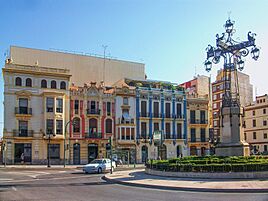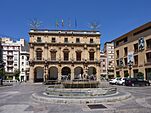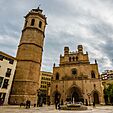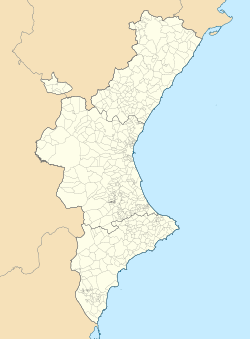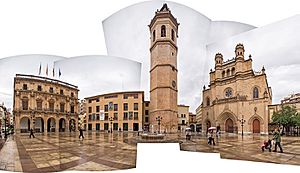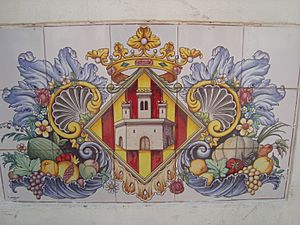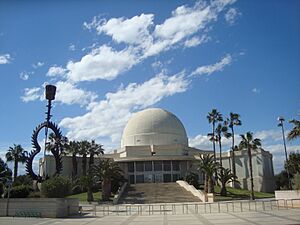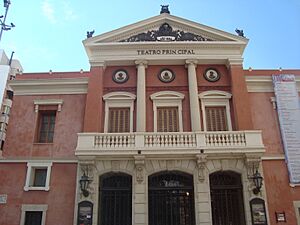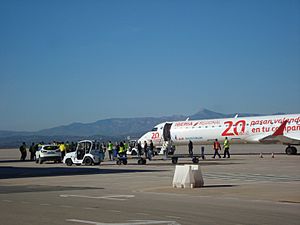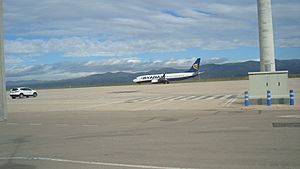Castellón de la Plana facts for kids
Quick facts for kids
Castellón de la Plana
|
|||
|---|---|---|---|
|
|
|||
|
|||
| Country | |||
| Autonomous community | |||
| Province | |||
| Comarca | Plana Alta | ||
| Judicial district | Castellón de la Plana | ||
| Area | |||
| • Total | 108.78 km2 (42.00 sq mi) | ||
| Elevation | 30 m (100 ft) | ||
| Highest elevation | 609 m (1,998 ft) | ||
| Lowest elevation | 0 m (0 ft) | ||
| Population
(2022)
|
|||
| • Total | 171,857 | ||
| • Density | 1,579.86/km2 (4,091.81/sq mi) | ||
| Demonyms | • castellonenc, -ca (va) • castellonense (es) |
||
| Time zone | UTC+1 (CET) | ||
| • Summer (DST) | UTC+2 (CEST) | ||
| Postal code |
12001-06
|
||
| Dialing code | 964 | ||
| Official language(s) | Valencian, Spanish | ||
| Climate | BSk | ||
Castellón de la Plana (also called Castelló de la Plana in Valencian) is a lively city in Spain. It's the capital of the Province of Castellón, located in the Valencian Community. You can find it on the eastern side of the Iberian Peninsula, right by the Mediterranean Sea on a beautiful coast called the Costa del Azahar. Inland, north of the city, you'll see the Desert de les Palmes mountain range.
In 2018, about 174,264 people lived in Castellón. This makes it the fourth biggest city in the Valencian Community. A cool fact about Castellón is that the Prime Meridian (the imaginary line that divides the Earth into East and West) crosses the 40th parallel right here! There's even a special monument in Meridian Park (Parc del Meridià) to mark this spot.
Contents
What's the History of Castellón?
The city's name comes from an old castle on top of Magdalena hill. This castle, called the Castle of Fadrell, was built by the Moors. It watched over the area where Castellón and Almassora are today.
In 1233, King James I of Aragon took control of the area. People tried to build new towns, but it wasn't easy. In 1251, King James I gave permission for people to move from the castle down to the flat plains. Tradition says this move happened in 1252.
During the Middle Ages, the city was protected by walls and towers. A church was also built, which later became a cathedral.
In the 16th century, Castellón was a strong place during a local uprising by guilds (groups of skilled workers). Later, in the 18th century, the city supported Archduke Charles during a big war over who would be king of Spain. But the troops of Philip V eventually took over.
In the 19th century, the city started to grow. The old city walls were taken down. The Peninsular War against Napoleon and other conflicts slowed things down. But in 1833, Castellón became the capital of its province. After that, the city grew again. A railway arrived, the port got bigger, and important buildings like a hospital and a theater were built.
In 1991, a university called Jaume I University was opened. Today, Castellón's economy relies on industries, tourism, and local crafts.
Weather and Nature in Castellón
Castellón de la Plana has a Semi-arid climate. This means it has mild winters and hot, dry summers. Autumn is usually the wettest time of year. The city enjoys about 2,800 hours of sunshine every year!
| Climate data for Castellón de la Plana, Almazora 43m (1981–2010), extremes (1940–) | |||||||||||||
|---|---|---|---|---|---|---|---|---|---|---|---|---|---|
| Month | Jan | Feb | Mar | Apr | May | Jun | Jul | Aug | Sep | Oct | Nov | Dec | Year |
| Record high °C (°F) | 28.0 (82.4) |
28.8 (83.8) |
30.2 (86.4) |
30.6 (87.1) |
35.0 (95.0) |
37.4 (99.3) |
40.6 (105.1) |
39.4 (102.9) |
36.0 (96.8) |
33.4 (92.1) |
29.0 (84.2) |
25.4 (77.7) |
40.6 (105.1) |
| Mean daily maximum °C (°F) | 15.3 (59.5) |
16.2 (61.2) |
18.5 (65.3) |
20.5 (68.9) |
23.4 (74.1) |
27.3 (81.1) |
30.0 (86.0) |
30.3 (86.5) |
27.6 (81.7) |
23.5 (74.3) |
18.8 (65.8) |
15.8 (60.4) |
22.3 (72.1) |
| Daily mean °C (°F) | 10.6 (51.1) |
11.3 (52.3) |
13.4 (56.1) |
15.4 (59.7) |
18.5 (65.3) |
22.5 (72.5) |
25.3 (77.5) |
25.6 (78.1) |
22.9 (73.2) |
19.0 (66.2) |
14.3 (57.7) |
11.4 (52.5) |
17.5 (63.5) |
| Mean daily minimum °C (°F) | 5.8 (42.4) |
6.4 (43.5) |
8.3 (46.9) |
10.3 (50.5) |
13.6 (56.5) |
17.6 (63.7) |
20.6 (69.1) |
20.9 (69.6) |
18.1 (64.6) |
14.4 (57.9) |
9.8 (49.6) |
7.0 (44.6) |
12.7 (54.9) |
| Record low °C (°F) | −4.4 (24.1) |
−2.2 (28.0) |
0.4 (32.7) |
2.8 (37.0) |
5.2 (41.4) |
10.2 (50.4) |
12.0 (53.6) |
12.2 (54.0) |
9.8 (49.6) |
5.4 (41.7) |
−1.8 (28.8) |
−0.6 (30.9) |
−4.4 (24.1) |
| Average precipitation mm (inches) | 36 (1.4) |
31 (1.2) |
31 (1.2) |
42 (1.7) |
44 (1.7) |
19 (0.7) |
9 (0.4) |
24 (0.9) |
71 (2.8) |
70 (2.8) |
49 (1.9) |
42 (1.7) |
467 (18.4) |
| Average precipitation days (≥ 1 mm) | 4 | 4 | 3 | 5 | 5 | 3 | 1 | 2 | 5 | 5 | 4 | 4 | 46 |
| Average relative humidity (%) | 67 | 66 | 64 | 63 | 63 | 63 | 64 | 66 | 68 | 69 | 68 | 68 | 66 |
| Mean monthly sunshine hours | 180 | 179 | 209 | 235 | 272 | 296 | 329 | 290 | 229 | 203 | 173 | 164 | 2,755 |
| Source: Agencia Estatal de Meteorología | |||||||||||||
Awesome Places to See
Most of Castellón's old buildings are in the small old town, around the Plaça Major (Main Square). Here are some highlights:
- The Concatedral de Santa Maria (co-cathedral of Saint Mary) was first built in the 13th century. It was rebuilt after a fire and again after being damaged in the Spanish Civil War.
- The Ajuntament (City Hall) was built in the early 18th century. It has a cool front with columns.
- El Fadrí (the single man) is a tall bell-tower next to the co-cathedral. It was built in the 15th century and stands on its own.
- The Llotja del Cànem (Hemp Exchange Market) was built in the 17th century. It was a place for traders to sell hemp cloth and ropes, which were very important back then. Now, the university uses it for cultural events.
- On the edge of town, you'll find the Basílica of Santa Maria del Lledó. This church is dedicated to an image of the Virgin Mary found by a farmer in 1366. The original chapel was made bigger in the 16th century.
- The Espai d'Art Contemporani de Castelló is a museum for modern art.
- The Teatre Principal is a main theater in the city.
Fun Events and Festivals
Castellón has a big annual festival called La Magdalena. It's a week of celebrations held three weeks before Easter each year. People from all over the province come to enjoy it. Many international bands and groups also take part in the fun!
Sports Teams and Activities
Castellón is home to several sports teams:
- The city has a professional basketball team called AB Castelló. They play in the LEB Oro, which is Spain's second basketball division.
- The local professional football club is CD Castellón. They play their home games at Nou Estadi Castàlia, which can hold 15,500 fans. Even though the club has faced challenges, it has a lot of support from its fans.
- Castellón also has a futsal (a type of indoor football) club called CFS Bisontes Castellón. This club, once known as Playas de Castellón, was one of the best in Spain and Europe in the early 2000s. They won Spain's top professional futsal league twice and the UEFA Futsal Cup three times in a row!
Learning in Castellón
Jaume I University was started in 1991. In 2014, about 15,000 students were studying there. All the students share one modern campus.
Friends Around the World (Twin Towns)
Castellón has "twin towns" in other countries. This means they have special friendly relationships and often share cultural events.
 Châtellerault, France
Châtellerault, France Târgoviște, Romania
Târgoviște, Romania Ube, Japan
Ube, Japan Lleida, Spain
Lleida, Spain
Famous People from Castellón
Many interesting people were born or lived in Castellón, including:
- Pierre Méchain (born 1744), a mathematician and astronomer.
- Sergio Aragonés (born 1937), a famous comics cartoonist.
- Roberto Bautista-Agut (born 1988), a professional tennis player.
- Sergio García (born 1980), a professional golfer.
- Pablo Hernandez Dominguez (born 1985), a footballer.
- Roberto Merhi, (born 1991), a racing driver.
- Miguel Angel Silvestre, (born 1982), an actor.
Getting Around Castellón
Castellón has a small airport, Castellón Airport, for charter flights and some regular passenger services. The newer Castellón-Costa Azahar Airport was built to handle larger international flights.
The city also has a railway station, Castellón de la Plana railway station. You can take the Euromed train line to cities like Alicante and Barcelona.
For getting around the city, Castellón has a modern public transport system called TRAM of Castellón. It uses trolleybuses. There is currently one line, Línia 1 (TRAM of Castellón), and plans for more in the future.
Images for kids
See also
 In Spanish: Castellón de la Plana para niños
In Spanish: Castellón de la Plana para niños


